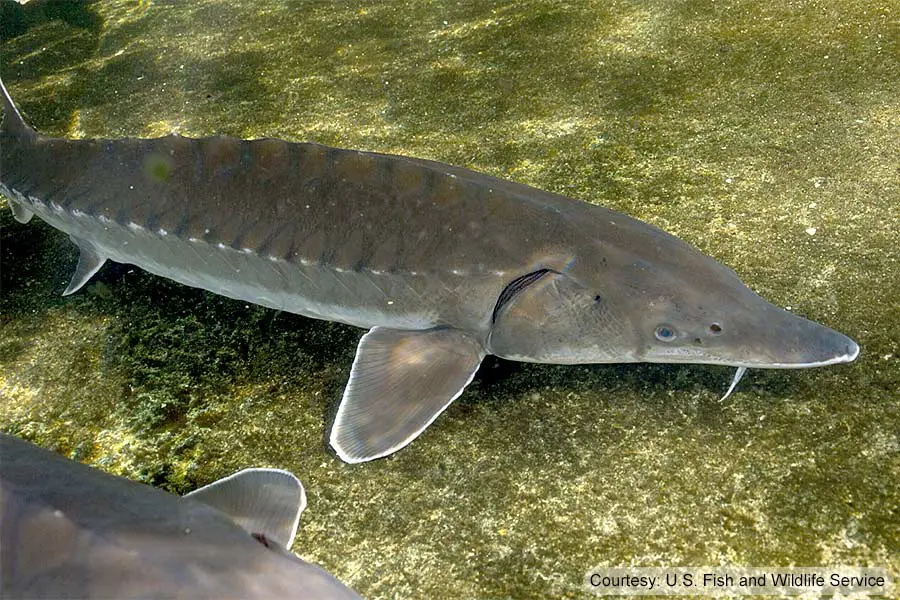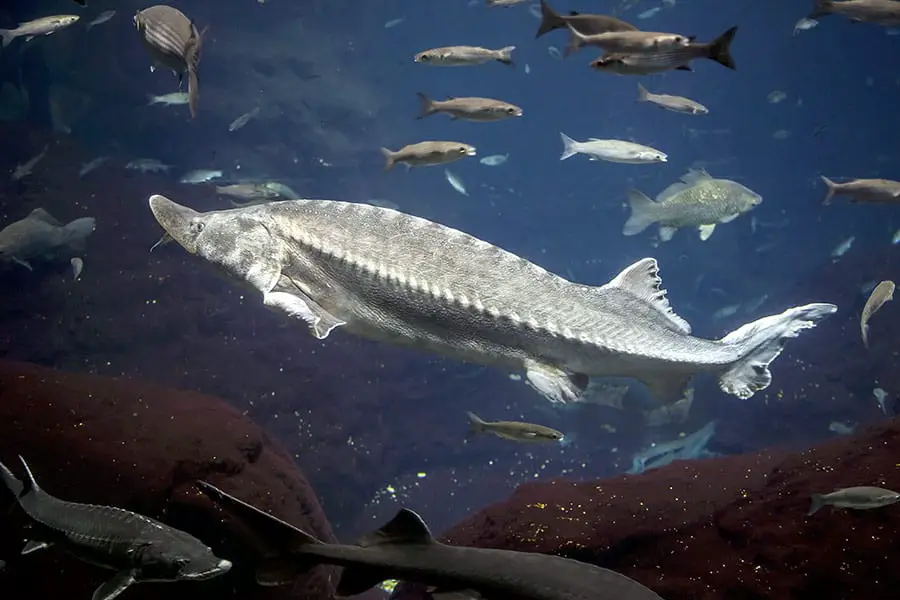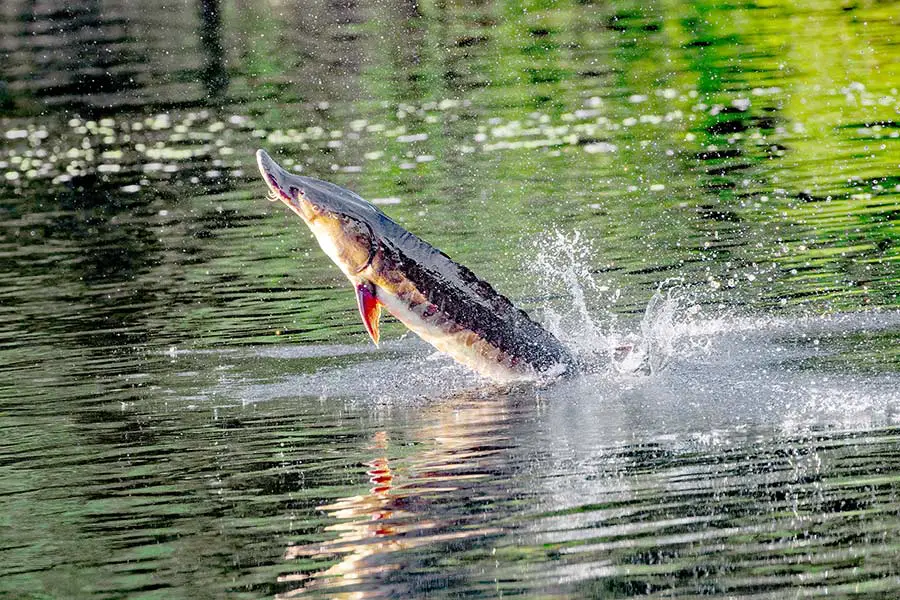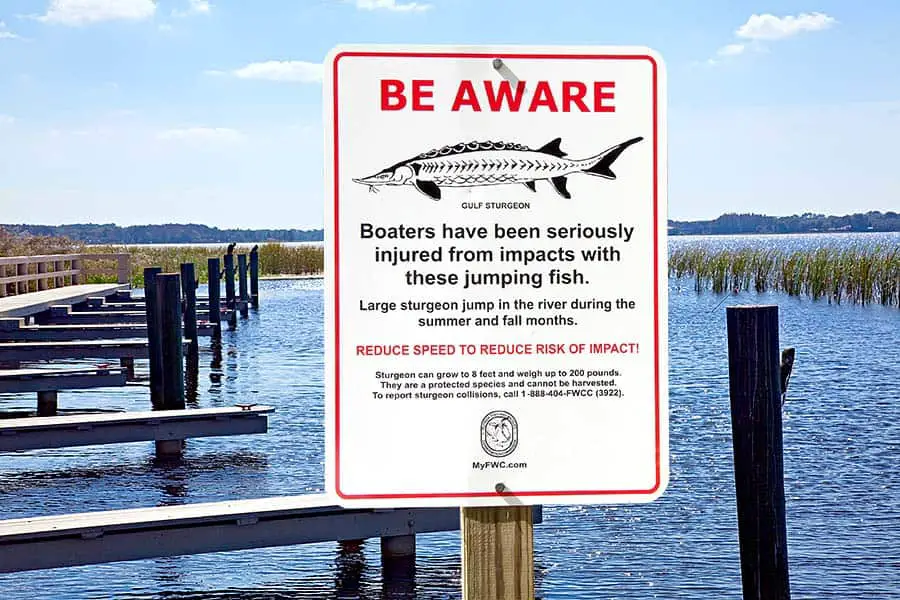
Fishing is one of Florida’s most famous pastimes. Whether you’re casting a line off a dock on the coast, reeling in a Marlin from a charter boat, or trolling for bass in one of Florida’s many fabulous freshwater lakes, most everybody in Florida loves to fish. But, while you can catch a variety of fish in Florida, many anglers wonder: are sturgeon protected in Florida?
Sturgeons are protected by federal and state law. The Endangered Species Act provides federal protections to sturgeons in U.S. territorial waters, and Florida state law protects sturgeons located in Florida’s coastal and inland waterways. It is illegal to fish for, catch, or keep sturgeon.
How many sturgeon are left in the wild? What happens if you mistakenly catch a sturgeon? Why do they jump out of the water? How big are they, and has anyone ever been killed by a sturgeon? As you continue on, you will learn the answers to these questions and more.
Advice From The Sturgeon General – It is Illegal to Fish For, Catch, or Keep Sturgeon
Sturgeons are a species of fish belonging to the family known as Acipenseridae. Sturgeons have been on earth in one form or another for thousands of years. Despite the tremendous age of the sturgeon family, these fish haven’t changed much over the eons: the fossils from thousands of years ago look very much like modern-day sturgeons.
Modern sturgeons are large fish. Full-sized adult sturgeons can be anywhere from six to eight feet long and weigh more than 200 pounds. Like many species of fish, in sturgeons, the female grows larger than the male. Both sexes have five rows of thorny dermal plates that run along the length of their body, making this fish a sort of water-dwelling tank.

Sturgeon are found in freshwater, saltwater, and brackish estuaries between the two. When spawning, sturgeon move into freshwater areas, where they focus primarily on reproducing, barely stopping to eat. During this time, they can lose up to 20% of their body weight. Their spawning period spans two months twice a year. Sturgeon lay eggs and reproduce in the spring months of March and April and again in October and November.
During their spawning time, female sturgeons can produce up to 500,000 eggs. However, regular forces of nature such as predation, disease, accidents, and environmental concerns mean that most of these eggs will not survive to adulthood. Fortunately for sturgeon, only two of the 500,000 or so eggs need to live to adulthood to keep the species viable.
Between spawning periods, sturgeon migrate to the ocean to hunt. These fish love to eat insect larvae, marine invertebrates, crabs, worms, and mollusks, and they can increase their body weight tremendously during these periods of gorging.
This hectic lifestyle of feeding and reproducing seems to work well for sturgeons. The average individual will live somewhere between 20 and 25 years in the wild. However, long-lived individuals can live up to 60 years.

There are three species of sturgeon in Florida’s waters. The Atlantic sturgeon (Acipsener oxyrinchus oxyrinchus) plies the waters from Cape Canaveral to Florida’s northern waters.
The Gulf sturgeon (Acipenser oxyrinchus desotoi), as one might expect, occurs along the Gulf coast and in many coastal waterways, most famously the Suwannee River.
Finally, Florida is also home to the shortnose sturgeon (Acipenser brevirostrum), which is quite rare and found only in a few places along the far Northeastern coast and the St. John’s River.
Sturgeons are considered a “threatened” species. Sturgeons have been listed as threatened since 1991 due to human activity like overfishing, habitat destruction, and the construction of dams.
But, what exactly does it mean that these fish are “threatened?” Under the Endangered Species Act, species are defined as threatened if they are “likely to become an endangered species within the foreseeable future throughout all or a significant portion of its range.”
All three species of sturgeons found in Florida — Atlantic, Gulf, and Shortnose — are protected by federal law under the Endangered Species Act. All three species are also protected under Florida state law, which is enforced by the state, county, and local law enforcement agencies.
Therefore, the capture or taking of any sturgeon — Atlantic, Gulf, or shortnose — is punishable by fines and possibly jail time.
Other Posts of Interest
- Are There Sharks In Tampa Bay?
- Which Florida Coast Is Better for Fishing?
- What Kind Of Fish Are In Biscayne Bay?
- Is Red Tide A Problem In Florida?
Phenomenal Florida Fun Fact: Sturgeons don’t have any teeth! Despite their impressive size and agility, sturgeon hunt by using special sensitive barbels on their snout and sucking food into their mouths.
Where Are Sturgeon Found in Florida?
Sturgeon can be found along the northern portions of Florida’s Atlantic and Gulf coasts and in several rivers throughout the state.
Some of the best rivers to see Sturgeon are:
- Apalachicola River
- Yellow River
- Blackwater River
- Choctawhatchee River
- Escambia River
- Pascagoula River
- Suwannee River
Perhaps the best place to see sturgeon is the Suwannee River. The Suwannee is known for having several great places to see sturgeon jumping.
If you want to see these fantastic fish leap out of the water, some of the best spots along the Suwannee are the junction of the Suwannee and Santa Fe Rivers, the area near Old Town Trestle, Usher Landing, Jack’s Sandbar, and Fanning Springs.
Can You Catch Sturgeon in Florida?
You can not catch sturgeon in Florida. Harvesting sturgeon can lead to jail time or fines, and the Florida Fish and Wildlife Commission does actively patrol the state’s waterways. In addition, all three sturgeon species are protected under the law.
While accidental sturgeon catches do sometimes happen, as long as you let the fish rest and recover before releasing it, you are unlikely to get in trouble for an accidental capture.

What to Do if You Accidentally Catch a Sturgeon in Florida?
If you do accidentally catch a sturgeon, you should handle it with care. You should keep the fish in the water and carefully remove any hooks or other equipment. If you can’t remove the hook, cut the line. While the fish is resting and recovering, you should keep it supported in the water. Do not agitate, harass, or otherwise cause harm to the fish.
Is it Illegal to Take a Sturgeon Out of the Water?
If you catch a sturgeon, you should leave it in the water. Taking it out of the water could be considered harvesting or capturing it, which could lead to penalties or jail time.
The only time you should remove a sturgeon from the water is if you need to take out hooks. In that situation, you should use a wet rag while handling the fish and be sure to support the fish’s belly.
How Many Gulf Sturgeons are Left?
An exact count of Gulf sturgeon doesn’t currently exist. However, population counts in specific habitats do exist. For example, the Suwannee River, one of the most important and densely populated sturgeon habitats, is estimated to have a population of somewhere around 10,000 individual fish.
Other rivers and bodies of water have smaller populations of sturgeon, but aggressive efforts by conservation authorities can likely help this remarkable fish remain viable for decades to come.

Why do Florida Sturgeon Jump out of the Water?
Marine biologists and other piscine science enthusiasts have determined that sturgeon jump for two reasons. First, it helps them maintain equilibrium in their swim bladder, which keeps them buoyant.
Second, jumping out of the water may be a means of communication, a signal between fish to indicate danger, mark territory, or send some other kind of message.
Finally, sturgeon might jump because they enjoy it!
Has Anyone Been Killed by a Sturgeon?
Watching the sturgeon jump is amazing, but sometimes they will jump directly into the path of mariners or anglers. Occasionally, a sturgeon will collide with a human being, which can cause serious injuries: these fish can weigh 200 pounds, so being struck by a jumping sturgeon is like being tackled by a grown man.
Some people have needed reconstructive surgery after being hit by jumping sturgeons. In 2015, Florida suffered its first known fatality from a sturgeon strike when a 5-year-old girl was struck by a sturgeon and killed near Fanning Springs.
To avoid being injured by a jumping sturgeon, you should exercise caution when boating in sturgeon-dense areas like the Suwannee River. Boaters should go slow, stay off the bow, and wear life vests when maneuvering through places where sturgeon jump.
If you are struck by a jumping sturgeon, you should treat your injuries and get proper medical attention. After treating any injuries, report the strike to the FWC Wildlife Alert Hotline by calling 1-888-404-3922.
Acrobatic Fish, Protected by Law
Florida’s expansive coastline, massive network of rivers, and an assortment of freshwater lakes provide it with a wonderful diversity of marine life. One of the state’s most interesting fish species is the sturgeon, which can be seen jumping into the air in several of Florida’s finest waterways.
These unique fish are amazing to see and observe but are facing challenges from dams, environmental changes, and human pressure that threaten the continued existence of these remarkable creatures.
The conservation of the species depends on human beings finding ways to coexist with these fish and meet the needs of man and sturgeon alike.
The legal protections afforded to sturgeons will help keep this species alive for generations to come. Someday, you may be able to sail the Suwannee and watch the sturgeons jump with your grandchildren, sharing delight in the antics of these acrobatic fish.





